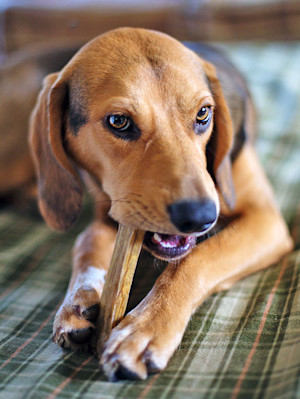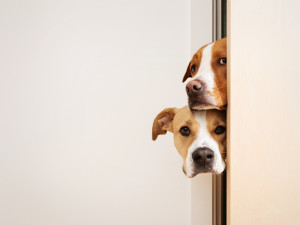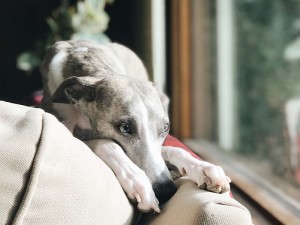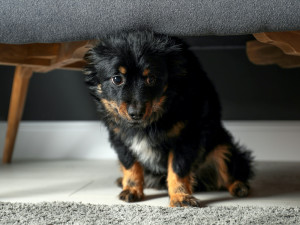Is Your Pup ‘Neophobic’? These Are The Signs To Look Out For
Help your dog overcome the fear of the unknown
There are bold dogs who wholeheartedly embrace novelty, jump into the water before knowing they can swim, or stride into a café they’ve never visited like they own the place. But, like humans, some dogs fear novelty, and this anxiety can be overwhelming. These dogs could be experiencing neophobia: a fear of new things.
This isn’t just a simple Hmm, I’m not sure about this hesitation from your dog; neophobia usually presents itself as an out-of-proportion fear or anxiety response. Your dog may view meeting a new friend with the same terror as they would a vet holding a needle, exhibiting a fight-or-flight response and body language indicating stress and fear.
If you think your dog may be neophobic, read on to learn how to spot the signs, what causes the issue and how to help your pup be less fearful of experiencing new things.
What is neophobia in dogs?
Neophobia in dogs is fear, or avoidance, of new things. Neophobic dogs show fearful behaviour in new environments, around unfamiliar objects, people or animals they have never seen before.
Dr Tammie King, an animal behaviour researcher at the Waltham Petcare Science Institute, explains socialisationopens in new tab is crucial for puppies to help reduce the chance of neophobia in later life. This socialisation is vital during their ‘sensitive period’, which commences during the third week and lasts until around 12 weeks of age. She says, “We know from the existing researchopens in new tab that early life exposure to a range of stimuli, conducted in a positive manner can reduce neophobic responses later in life.”
Socialising your puppy involves introducing them to a range of new experiences, including meeting different types of people, dogs, other animals, places, smells and noises. It’s important to gently introduce your puppy to new situations and reward them for calm behaviour.
When considering adopting a dog that has passed the ‘sensitive period’, Dr King suggests enquiring about the dog’s recent socialisation experiences and their reactions. “You should not assume they have already been exposed to all the stimuli they will encounter living with you,” she says. ��“Knowing their background and personality traits can help you decide whether this dog will be a good fit for you.”
How to tell if your dog is neophobic
Does your dog cower under the bed to avoid encountering new visitors, quiver in fear at even the sight of a hoover or refuse to enter new spaces? There’s a chance they may be neophobic.
I am lucky enough that my dog Bonnie adores meeting new people and other dogs. Unfortunately, however, she is frequently spooked by new objects. When my dad had a new greenhouse built in his back garden earlier this year, Bonnie refused to enter the garden and then barked ferociously at the greenhouse as if it was an intruder. It took weeks of gradual desensitisation to help her understand that ‘new’ doesn’t have to be scary.
Chances are, you will know your own dog’s fear responses, but the classic signs of fear in dogs include:
Avoidance behaviour: a worried dog may try to run away or freeze when confronted with something new.
Fearful body language: this may include crouching, trembling or tucking their tail between their legs.
Vocalisations: dogs may bark, whine, or snarl when fearful.
Destructive behaviour: fearful dogs may become destructive, chewing on furniture or digging holes in the garden.
Excessive grooming.
Dogs may pace, pant, drool, yawn or lick their lips excessively when anxious.
When exposed to unfamiliar stimuli, dogs might become hostile in extreme cases.
Causes of neophobia
As well as lack of socialisation, Dr King says neophobia in dogs can be caused by several circumstances, including:
Genes: some dogs may be predisposed to fearfulness due to genetics, and even before the puppies are born, how the mother feels before, during, and after pregnancy can play a part in how confident a dog is. A 2021 studyopens in new tab showed that puppies born to stressed mothers are more likely to suffer from anxiety and, therefore, are often less confident about trying new things.
Traumatic events: for some dogs, a negative experience can greatly impact how they deal with new things. If they experience trauma in the presence of humans, other dogs, or animals, it could change how they feel in these situations in the future.
Medical conditions: pain, hearing loss or visual impairment might make dogs wary or scared. If your previously calm dog suddenly becomes fearful, a trip to the vet to rule out an underlying medical issue may be in order.
Changes in routine: dogs are creatures of habit and enjoy predictability, and big changes to their routine or surroundings can make them fearful.
Potential problems caused by neophobia
Living with a dog afraid of new things can make you feel isolated. You may avoid inviting friends over, visiting a new park or even wearing a hat when it’s cold in case your dog is scared of you. A dog living in fear of the unknown is unhappy, and it can be heartbreaking to watch them react with fear to new situations.
Failing to address situations that negatively impact your dog’s mental health may lead to behavioural problems that could compromise your dog’s quality of life. A scared or anxious dog may behave aggressively and growl or bite if they cannot escape a stressful situation.
Helping your dog deal with neophobia may be at the top of your priority list, but as canine behaviourist Caroline Wilkinsonopens in new tab says, a stressed dog cannot take on effective learning. “When dogs are relaxed, they can seek out social connections and learning opportunities and are open to rewards through food or play. When they are stressed, they are more likely to want to seek safety and avoidance of interactions. Building a dog’s confidence slowly, with space and time to make decisions for themselves, is really important.”
How to help a neophobic dog
Dr King says there are several ways to help a neophobic dog, and a combination of desensitisation and counter-conditioning are key. Every dog is individual; some love to train, some love to track and find the scent, and others love to play. Work out what motivates your dog and do this with them daily, helping them to create positive associations in the brain that will help with future training.
Desensitisation
Desensitisation involves gradually and systematically being exposed to a trigger stimulus until it no longer triggers an emotional response. It begins with a very low intensity of exposure – low enough that any reaction is minimal. The intensity gradually increases over several sessions until there is no emotional response, even when the stimulus is presented at full intensity.
Ensure your dog’s environment is safe, familiar, comforting and reassuring, and only introduce one new stimulus at a time. Desensitisation mustn’t be rushed. Monitor your dog’s body language for signs of stress and remove them from the situation if they are no longer comfortable.
Counterconditioning
Counterconditioning is a technique in which a stimulus that creates a negative emotional response is paired with something known to make a positive emotional response in the animal.
For example, suppose your dog is frightened when they see a cyclist. In that case, you may induce a positive emotional state by giving him a treat when you see a cyclist from a distance. Utilise positive reinforcement by rewarding desirable behaviour and pairing fun things (like pats, treats and toys) with new stimuli.
Monitor your own response
When your dog encounters something that scares them, your attitude matters! Never force your dog to interact with what scares them. Talk to your dog in a cheerful tone and reward them with high-value treats if they take the initiative to approach something unfamiliar. Work on your dog’s day-to-day training and responsiveness; a well-trained dog will look to you for direction and be more willing to follow your lead by stepping into the unknown without fear.
Seek professional help
If you’ve tried everything and feel that you’re not making progress with your neophobic dog, there’s no shame in seeking support from a qualified pet behaviourist. Look for a behaviourist accredited with a recognised professional organisation who understands and can apply evidence-based learning principles to treating your dog. Be wary of trainers or behaviourists who believe in forcing dogs to experience things they are stressed by and offer a ‘quick fix’ because behaviour modification takes time, patience and effort.








